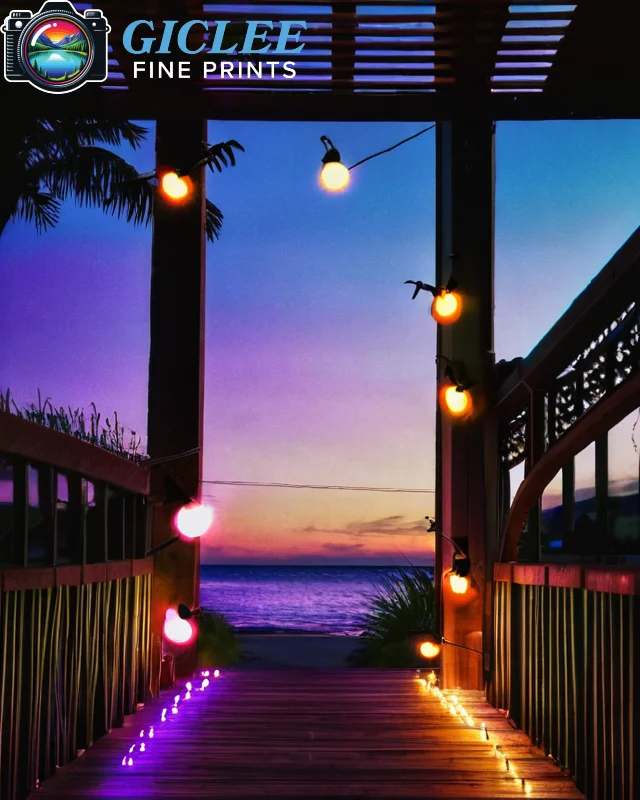
Matting photo prints can elevate the visual appeal, give them a polished look, and protect the image from potential damage. A well-chosen mat adds depth, draws attention to the photo, and ensures that it fits perfectly into standard frames. At Giclee Fine Prints, we provide tips for matting photo prints to achieve a professional presentation.
Select the Right Mat Size for Standard Frames
Choosing the correct mat size is essential for a balanced presentation and ensuring the print fits securely in the frame. Standard frames come in sizes like 8×10, 11×14, and 16×20 inches, with mats that fit various photo dimensions.
Key Tips:
- Choose a Mat with a Standard Outer Dimension: For example, an 8×10-inch mat fits into an 8×10 frame but may be cut to hold a 5×7 or 4×6 photo inside.
- Inner Cut Size: The inner cut (window) should be slightly smaller than the photo. For a 5×7 photo, choose a mat window of about 4.75×6.75 inches to ensure the photo edges are covered and held securely.
- Proportionate Mat Borders: Keep mat borders proportional to the frame size. Wider borders work well for large frames, while narrower borders are suitable for smaller frames.
Best For:
- Portraits, family photos, and fine art photography that benefit from a well-fitted mat in standard frames.
Consider the Matting Color
Choosing the right mat color complements the photo and enhances the overall presentation. Neutral tones are the most versatile, but subtle color accents can enhance specific elements within the photo.
Key Tips:
- Neutral Tones: White, off-white, cream, or light gray mats work with most photos, providing a clean and professional look.
- Colored Mats: Use a colored mat to highlight a specific tone within the photo, such as a soft blue for beach scenes or a warm tan for autumn landscapes.
- Double Matting: A second, narrower mat underneath the main mat can add a pop of color or depth. Choose a color that complements the primary mat and the photo for an elevated look.
Best For:
- Versatile displays, where the mat color can subtly enhance the print without overpowering the image.
Choose Acid-Free, Archival Matting Materials
Acid-free matting materials prevent discoloration, yellowing, and damage over time. Using high-quality, archival mats ensures that your photos retain their original quality for years.
Key Tips:
- Acid-Free Mats: Always use acid-free or archival mats to prevent the photo from yellowing or deteriorating over time.
- Lignin-Free: Lignin-free mats are ideal for long-term preservation, as lignin can degrade and release harmful acids over time.
- Protective Backing: Choose an acid-free backing board to further protect the print within the frame.
Best For:
- Preserving family heirlooms, wedding photos, and fine art prints that you want to keep in excellent condition.

Determine the Mat Border Width
The mat border width affects how the image is framed visually. A well-balanced mat border draws attention to the photo and prevents the frame from overwhelming the image.
Key Tips:
- Standard Border Widths: For most photos, a border width between 1.5 and 3 inches works well. For smaller photos, use a narrower mat, while larger images benefit from wider borders.
- Bottom-Weighted Mats: For an extra professional touch, consider using a slightly wider bottom border, which gives visual stability to the print.
- Consider Frame Size: Larger frames can handle wider borders without looking unbalanced, while smaller frames may look best with narrower borders.
Best For:
- Single-photo frames and gallery walls, where consistent matting enhances the display’s aesthetic.
Use the T-Hinge Method for Mounting the Photo
Properly mounting the photo to the mat ensures it stays in place without damaging the print. The T-hinge method is a standard technique that allows the photo to expand and contract naturally with temperature changes.
Key Tips:
- Use Archival Tape: Acid-free hinging tape is ideal for securing the photo to the mat without damaging it.
- T-Hinge Technique: Apply two small pieces of tape at the top of the photo, creating a T-shape with the adhesive. This prevents shifting while allowing slight movement with changes in humidity.
- Avoid Over-Taping: Only secure the top of the photo to allow it to hang naturally within the mat. Over-taping can lead to warping.
Best For:
- Protecting the photo while ensuring a secure mount within the mat.
Choose Between Single and Double Matting
Deciding between single and double matting depends on the effect you want to achieve. Double mats add depth and dimension to the display, creating a more refined look.
Key Tips:
- Single Matting: A single mat is classic and minimal, perfect for simple, elegant displays.
- Double Matting: Adding a second mat creates a layered effect. Choose a subtle accent color for the inner mat that complements the main mat or an element in the photo.
- Spacing Between Mats: Leave a narrow reveal of about 1/8 inch for the inner mat. This creates a subtle accent without overpowering the photo.
Best For:
- High-end photo displays and gallery-style presentations, where a touch of depth enhances the artwork.

Consider Anti-Reflective and UV-Protective Glass
The right glass protects your photo while allowing the details to remain clearly visible. UV-protective and anti-reflective glass options provide the best viewing experience and prevent fading.
Key Tips:
- UV-Protection: UV-protective glass reduces fading and discoloration caused by sunlight exposure, preserving color and detail.
- Anti-Reflective Glass: Non-reflective or museum-quality glass minimizes glare, making the photo easier to view in different lighting conditions.
- Acrylic Options: For larger frames, consider using acrylic instead of glass. Acrylic is lightweight, shatter-resistant, and available with UV and anti-reflective coatings.
Best For:
- Photos in well-lit areas or pieces displayed for long periods, where added protection ensures longevity.
Select the Right Frame for Your Matted Print
The frame complements the matting and enhances the overall presentation. Choosing a frame that suits both the mat and the photo ensures a cohesive look.
Key Tips:
- Coordinate with Mat Color: Select a frame that complements the mat color. A dark frame pairs well with a light mat, creating contrast that highlights the photo.
- Frame Style: Traditional wooden frames add warmth and elegance, while modern metal frames offer a sleek, minimalist look.
- Consistent Sizing: Ensure the frame matches the outer dimensions of the mat. Standard frames, such as 8×10 or 11×14 inches, make it easy to find compatible mats.
Best For:
- Various decor styles where the frame choice can align with modern, traditional, or minimalist aesthetics.
Contact Us
Our address is: 3816 Pioneer Trail Ste #3, South Lake Tahoe, CA 96150
Email: Info@gicleefineprints.com
FAQs
Select a mat with an outer dimension matching your frame and an inner cut slightly smaller than the photo to keep it secure. For a 5×7 photo in an 8×10 frame, for example, choose a mat with a 4.75×6.75 window.
Single matting is classic and simple, while double matting adds depth and a touch of sophistication. Double matting works best for high-end displays or gallery walls.
Neutral colors like white, off-white, or light gray are versatile and professional, working well with most photos. Colored mats can highlight specific tones in the photo.


